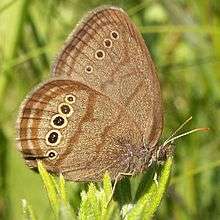Neonympha mitchellii
| Neonympha mitchellii | |
|---|---|
 | |
| Scientific classification | |
| Kingdom: | Animalia |
| Phylum: | Arthropoda |
| Class: | Insecta |
| Order: | Lepidoptera |
| Family: | Nymphalidae |
| Genus: | Neonympha |
| Species: | N. mitchellii |
| Binomial name | |
| Neonympha mitchellii French, 1889[2] | |
| Subspecies | |
| |
| Synonyms | |
Neonympha mitchellii is an endangered species of nymphalid butterfly of the eastern United States.[3] There are two known subspecies:[3]
- N. m. mitchellii, the nominate subspecies, commonly called Mitchell's satyr or Mitchell's marsh satyr,[5] is found in Michigan and Indiana.[3] The species is presumably extirpated from former ranges in Ohio (last seen in the 1950s), New Jersey (last seen in 1988), and Wisconsin.[3]
- N. m. francisci (see main article), commonly called Saint Francis' satyr, is found in a single metapopulation in a 10x10 km area of Fort Bragg in North Carolina.
Recent discoveries since 1998 of populations in Alabama, Mississippi, and Virginia are being studied for taxonomic classification, and may be grouped with N. m. mitchellii or be described as new subspecies.[3]
All subspecies, including those newly discovered, are federally protected under the Endangered Species Act.[3]
Description
Both subspecies are small, brown butterflies with a wingspan rage of 34–44 mm.[6][7] The upper surface of their wings are unmarked, while the undersides of the wings have rows of round, yellow-ringed eyespots.[8] N. m. francisci is slightly darker, with more irregularly shaped eyespots.[8]
Their eggs are greenish-white to cream, becoming tan as they age.[8] The larvae's dark head can be seen a day or two before hatching.[8] First instar larvae, 3–4 mm long, have dark brown bilobed heads, while four subsequent instars, 6–12 mm long, have green bilobed heads, and green bodies with raised white ridges along the sides.[3][8]
The chrysalis are 10.5–15.5 mm long, suspended with the head down.[3][8] It's a light lime green, with pale green or white speckling, and turns a medium brown about two days before eclosion.[3][8]
References
- 1 2 Schweitzer, DF (2011). "Comprehensive Report Species – Neonympha mitchellii". NatureServe Explorer. NatureServe Inc. Retrieved 20 December 2013.
- ↑ "ITIS Standard Report Page: Neonympha mitchellii francisci". Integrated Taxonomic Information System. Retrieved 19 December 2013.
- 1 2 3 4 5 6 7 8 9 10 11 Hamm, C. A.; Rademacher, V.; Landis, D. A.; Williams, B. L. (2013). "Conservation Genetics and the Implication for Recovery of the Endangered Mitchell's Satyr Butterfly, Neonympha mitchellii mitchellii" (PDF). Journal of Heredity. 105 (1): 19–27. doi:10.1093/jhered/est073. ISSN 0022-1503. Retrieved 19 December 2013..
- ↑ Dyar, HG (1902). A list of North American lepidoptera and key to the literature of this order of insects. Washington: Government Printing Office. p. 32.
- ↑ Albrecht, Carl W.; Watkins, Reed A. (July 1983). "mitchell's+marsh+satyr" A cross-reference to names of Ohio skippers and butterflies: (Insecta: Lepidoptera: Hesperioidea and Papilionoidea). College of Biological Sciences, The Ohio State University in cooperation with the Ohio Lepidopterists. p. 14. ISBN 978-0-86727-095-2. Retrieved 19 December 2013.
- ↑ "Neonympha mitchellii mitchelli" (PDF). Michigan Natural Features Inventory. College of Agriculture and Natural Resources, Michigan State University. Retrieved 20 December 2013.
- ↑ "Endangered and Threatened Wildlife and Plants; Emergency Rule To List the Saint Francis' Satyr as Endangered". Federal Register. 59 (74). Government Printing Office. 18 April 1994. Retrieved 20 December 2013.
- 1 2 3 4 5 6 7 "Critter Catalog: Neonympha mitchellii, Mitchell's satyr". BioKIDS – Kids' Inquiry of Diverse Species. The University of Michigan. Retrieved 20 December 2013.
